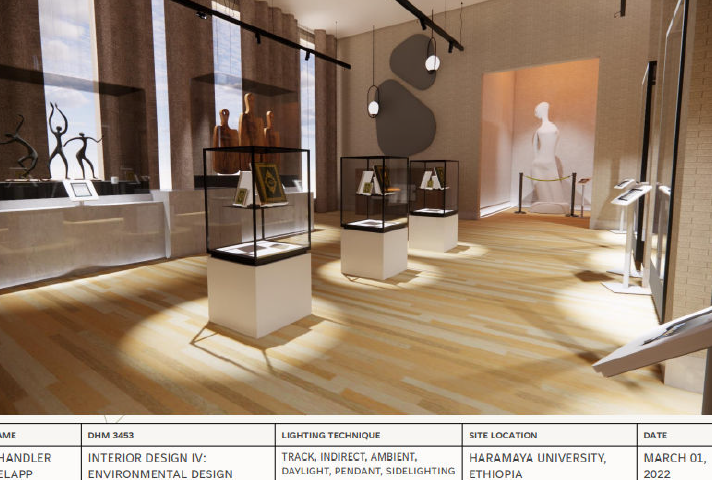Exploring the Ethiopian Museum Design Student Project: Contributions to an American Interior Design Program’s Accreditation
Main Article Content
Abstract
An American Interior Design program, located at a large University in the Midwestern United States of America sought key evidence of their students’ compliance with the Council for Interior Design Accreditation (CIDA) standards, in preparation for their 2021 accreditation site visit. Accreditation standards continue to evolve and are a recognized measure of interior design programs’ competence. Programs are required to develop an exhibit of student work for initial accreditation or their periodic site visits for re-accreditation, to write a report, and to provide key evidence of competency with several standards. In 2021, due to the global pandemic, the site visit exhibit was produced in a digital format and the site visitors reviewed all documentation online. University researchers pre-reviewed the digital inputs and outputs from 25 courses for the exhibit, including the students’ Ethiopian Museum Design project produced during three-year period, 2019-2021. This Ethiopian Museum Design project was completed during the interior design students’ third year course, Interior Design Studio IV: Environmental Design, which covers lighting and thermal/atmospheric comfort and their application using computer-aided and drafted techniques. Although museum projects are often assigned to students enrolled in interior design and architecture undergraduate programs, no previously published studies of interior design students’ museum projects’ compliance with interior design standards were found. Researchers found that the studied museum project contributed key evidence to four standards: Global Context, Human-Centered Design, Light and Color and Construction. The CIDA site visitors reviewed the program documents in 2020 and the Interior Design Program was notified of accreditation.
Article Details

This work is licensed under a Creative Commons Attribution-NonCommercial-NoDerivatives 4.0 International License.
References
Council for Interior Design Accreditation (CIDA), Professional Standards. (2020). Available: https://www.accredit-id.org/professional-standards/
C. Piotowski, Professional Practice for Interior Designers, Fourth Edition. John Hoboken, N.J.: Wiley & Sons, Inc., 2008.
Oklahoma State University, (2020). “Headlines: News and Media: School of Global Studies and Partnerships welcomes Ethiopia higher education representatives,” Wednesday, March 11, 2020 Available: https://news.okstate.edu/articles/globalstudies/2020/ethiopia_delegation.html
P. R. Hebert, (2021, September 8-10). “American University students select, display and illuminate Ethiopian artifacts for a University museum project”. Unpublished paper in Fourteenth International Conference on The Inclusive Museum, Lisbon, Portugal.
Oklahoma State University, (2016). 2016-2017 University Catalog, Stillwater, OK.
J. Dubois, (2008). “Roots and Flowerings of Ethiopia’s Traditional Crafts,” Available: https://unesdoc.unesco.org/ark:/48223/pf0000184662
Metropolitan Museum of Art (2022). Heilbrunn timeline of art history essays: “Ethiopia’s Enduring Cultural Heritage.” Available: https://www.metmuseum.org/toah/hd/ethi/hd_ethi.htm
P. R. Hebert, (2021, October 5-8). “Examining a University partnership during Covid 19 and virtual accreditations: Design program and art museum,” Unpublished poster presentation in Mountains-Plains Museum Association Conference, Sioux Falls, S.D.
C. Piotowski and E. Rogers, Designing Commercial Interiors, Second Edition. Hoboken, N.J.: John Wiley & Sons, Inc., 2007.
M. Embaby, (2014). “Heritage conservation and architectural education: An educational methodology for design studios,” HBRC Journal, vol 10:3, pp. 339-350.
Ö. Karakul, (2018). “Designing the museum of Turkey intangible cultural heritage: A Studio experience of interior architectural design,” Milli Folklor, vol. 30(120).
Berger, A. A., What Objects Mean: An Introduction to Material Culture, Second Edition. Walnut Creek, CA, 2014.
Foundation for Interior Design Education Research (FIDER), (1995). FIDER standards and guidelines: Professional level programs (FIDER form 402R), Grand Rapids, MI: FIDER,1995.
A. Asojo, (2008). “A Model for Integrating Culture-Based Issues in Creative Thinking and Problem Solving in Design Studios,” Journal of Interior Design, vol. 27(2), pp. 46-57. 02 June 2008. Available: https://doi.org/10.1111/j.1939-1668.2001.tb00477.x
T. Drab, (2008). “Prejudice as an Obstacle to Multiculturalism in the Teaching of Design History” Journal of Interior Design, 02 June 2008, vol. 24(2), pp. 12-16. Available: https://doi.org/10.1111/j.1939- 1668.1998.tb00324.x
V. Jani, (2011). Diversity in Design Perspectives from the non-Western World. Fairchild Books, NY.
A. Asojo, (2007). “Technology as a tool for globalization: Cross-cultural collaborative design studio projects,” Journal of Interior Design, vol. 33(2), pp. 23-36. Available: https://doi.org/10.1111/j.1939- 1668.2007.tb00319.x
P. R. Hebert and M. Erdley, (2021, May 24-25). “Addressing accreditation standards requiring global context for design: Students’ Ethiopia museum project,” Unpublished poster presentation in Phi Beta Delta Honor Society for International Scholars 35th Annual International Conference, Online.
I. Ang, (2005). “The Predicament of diversity: Multiculturalism in practice at the art museum,” Ethnicities, vol. 5(3): 305-320;054957 DOI: 10.1177/1468796805054957 Available: https://journals.sagepub.com/doi/10.1177/1468796805054957.
F. K. Smith, Bringing Interiors to Light. NY, NY: Watson-Guptill,1986.
N. C. Brown. (2004), “Aesthetic Composition and the Language of Light, a Subject of Academic Inquiry,” Journal of Interior Design, vol. 30: pp. 8-22. Available: https://doi.org/10.1111/j.1939-1668.2004.tb00522.x
G. Gordon, Interior Lighting for Designers, Fifth Edition. Hoboken, N. J.: Wiley & Sons, 2015.
S. Russell, The Architecture of Light, Second Edition. LaJolla, CA: Conceptnine, 2012.
Illuminating Engineering Society, (2018). “Luminaire,” Available: https://www.ies.org/definitions/luminaire/
L. O’Shea, L. and R. Awwad-Rafferty, Design and Security in the Built Environment. NY, NY: Conceptnine, 2009.
T. Hadjiyanni and J. Kwon, (2009). “The Social Dimension of Security: Exploring How Surveillance Systems Relate to Interior Design,” Journal of Interior Design 34(3) Available: https://doi.org/10.1111/j.1939-1668.2009.01020.x
Oklahoma State University (2022). OSU Museum of Art. Available: https://museum.okstate.edu/art/collections/index.html
L. Siddons, (2014). Sharing a Journey. Available: https://museum.okstate.edu/site-files/2014/sharing-a-journey/documents/catalog.pdf
Gaylord Bros. Inc., Gaylord Archival. Syracuse, NY: Gaylord Archival, 2020.
MBA Design and Display Products Corp., Mila-wall Movable Wall Panels. Exton, PA: MBA Design and Display Products Corp, (n.d.).
Council for Interior Design Accreditation (CIDA), (2021). Program Analysis Report (PAR) (Unpublished).
M. Jackson and P. R. Hebert, (2019, September 22-25). “Undergraduate students’ global engagement through museum design: Display, illumination and protection in Ethiopia,” Unpublished poster presentation in Mountains-Plains Museum Association Conference, Albuquerque, NM.
Y. Pei and P. R. Hebert, (2018, April, 4–7). “One student's solutions for an Ethiopian museum's artifact display and protection assignment, Unpublished paper presentation in Western Social Studies Association Conference, San Antonio, TX.


